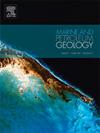Geochronology and geochemical characteristics of sulphides from Tianzuo hydrothermal field (63°32ʹ E), South West Indian Ridge
IF 3.7
2区 地球科学
Q1 GEOSCIENCES, MULTIDISCIPLINARY
引用次数: 0
Abstract
Tianzuo hydrothermal field (THF) in the eastern Southwest Indian Ridge (SWIR) is reported as an inactive ultramafic-hosted system and fragments of massive and altered sulphides were recovered from the hydrothermal field at (27°57′S, 63°32′ E). The sulphide formation happened in the THF in two phases, at both high-temperature and low to medium temperature environment. The mineral assemblages in massive sulphides suggest the contribution of high-temperature hydrothermal fluid in the ore formation process. The presence of covellite and Fe-oxy-hydroxides in the altered sulphides indicates a low to medium-temperature environment and subseafloor alteration of fluid by seawater mixing. Elevated ΣREE contents with no significant Eu anomaly in both massive and altered sulphides further supports the subseafloor hydrothermal fluid mixed with seawater. Elevated Pd and Rh concentrations, along with their positive correlation with Cu, suggest Pd and Rh fractionation during the seawater-hydrothermal fluid mixing. 230Th/U dating results of massive hydrothermal sulphide samples give the age of 24 kyr (±2.4) and 15.6 kyr (±0.8), and an incomplete sampling demonstrates a possible minimum age of the vent field.
西南印度脊天祚热液田(63°32′E)硫化物年代学及地球化学特征
据报道,西南印度洋脊(SWIR)东部的天祚热液田(THF)是一个不活跃的超镁铁质含矿系统,在(27°57'S, 63°32 ' E)热液田中发现了块状和蚀变硫化物碎片。在高温和中低温环境下,THF中硫化物的形成分两阶段发生。块状硫化物中的矿物组合表明高温热液在成矿过程中起作用。蚀变的硫化物中存在钴岩和铁氧氢氧化物,表明了中低温环境和海底流体的海水混合蚀变。块状和蚀变硫化物中ΣREE含量升高且无明显Eu异常,进一步支持海底热液与海水混合。Pd和Rh浓度的升高,以及它们与Cu的正相关,表明在海水-热液混合过程中Pd和Rh分馏。大量热液硫化物样品的230Th/U定年结果给出了24 kyr(±2.4)和15.6 kyr(±0.8)的年龄,并且一个不完整的采样证明了该喷口场可能的最小年龄。
本文章由计算机程序翻译,如有差异,请以英文原文为准。
求助全文
约1分钟内获得全文
求助全文
来源期刊

Marine and Petroleum Geology
地学-地球科学综合
CiteScore
8.80
自引率
14.30%
发文量
475
审稿时长
63 days
期刊介绍:
Marine and Petroleum Geology is the pre-eminent international forum for the exchange of multidisciplinary concepts, interpretations and techniques for all concerned with marine and petroleum geology in industry, government and academia. Rapid bimonthly publication allows early communications of papers or short communications to the geoscience community.
Marine and Petroleum Geology is essential reading for geologists, geophysicists and explorationists in industry, government and academia working in the following areas: marine geology; basin analysis and evaluation; organic geochemistry; reserve/resource estimation; seismic stratigraphy; thermal models of basic evolution; sedimentary geology; continental margins; geophysical interpretation; structural geology/tectonics; formation evaluation techniques; well logging.
 求助内容:
求助内容: 应助结果提醒方式:
应助结果提醒方式:


